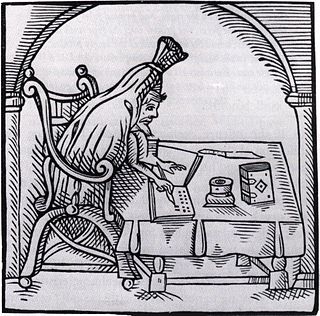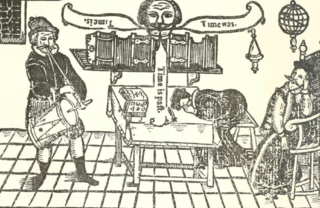
Roger Bacon, also known by the scholastic accolade Doctor Mirabilis, was a medieval English philosopher and Franciscan friar who placed considerable emphasis on the study of nature through empiricism. In the early modern era, he was regarded as a wizard and particularly famed for the story of his mechanical or necromantic brazen head. He is sometimes credited as one of the earliest European advocates of the modern scientific method, along with his teacher Robert Grosseteste. Bacon applied the empirical method of Ibn al-Haytham (Alhazen) to observations in texts attributed to Aristotle. Bacon discovered the importance of empirical testing when the results he obtained were different from those that would have been predicted by Aristotle.
This article contains information about the literary events and publications of 1594.
The Ur-Hamlet is a play by an unknown author, thought to be either Thomas Kyd or William Shakespeare. No copy of the play, dated by scholars to the second half of 1587, survives today. The play was staged in London, more specifically at The Theatre in Shoreditch as recalled by Elizabethan author Thomas Lodge. It includes a character named Hamlet; the only other known character from the play is a ghost who, according to Thomas Lodge in his 1596 publication Wits Misery and the Worlds Madnesse, cries, "Hamlet, revenge!"

The Merry Devil of Edmonton is an Elizabethan-era stage play; a comedy about a magician, Peter Fabell, nicknamed the Merry Devil. It was at one point attributed to William Shakespeare, but is now considered part of the Shakespeare Apocrypha.
Fair Em, the Miller's Daughter of Manchester, is an Elizabethan-era stage play, a comedy written c. 1590. It was bound together with Mucedorus and The Merry Devil of Edmonton in a volume labelled "Shakespeare. Vol. I" in the library of Charles II. Though scholarly opinion generally does not accept the attribution to William Shakespeare, there are a few who believe they see Shakespeare's hand in this play.
Queen Elizabeth's Men was a playing company or troupe of actors in English Renaissance theatre. Formed in 1583 at the express command of Queen Elizabeth, it was the dominant acting company for the rest of the 1580s, as the Admiral's Men and the Lord Chamberlain's Men would be in the decade that followed.

A brazen head, brass, or bronze head was a legendary automaton in the early modern period whose ownership was ascribed to late medieval scholars, such as Roger Bacon, who had developed a reputation as wizards. Made of brass or bronze, the male head was variously mechanical or magical. Like Odin's head of Mimir in Norse paganism, it was reputed to be able to correctly answer any question put to it, although it was sometimes restricted to "yes" or "no" answers. In the seventeenth century, Thomas Browne considered them to be misunderstanding of the scholars' alchemical work, while in modern times, Borlik argues that they came to serve as "a metonymy for the hubris of Renaissance intellectuals and artists". Idries Shah devotes a chapter of his book The Sufis to providing an interpretation of this "head of wisdom" as well as the phrase "making a head", stating that at its source the head "is none other than the symbol of the [Sufic] completed man."

Richard Field (1561–1624) was a printer and publisher in Elizabethan London, best known for his close association with the poems of William Shakespeare, with whom he grew up in Stratford-upon-Avon.
Thomas Creede was a printer of the Elizabethan and Jacobean eras, rated as "one of the best of his time." Based in London, he conducted his business under the sign of the Catherine Wheel in Thames Street from 1593 to 1600, and under the sign of the Eagle and Child in the Old Exchange from 1600 to 1617. Creede is best known for printing editions of works in English Renaissance drama, especially for ten editions of six Shakespearean plays and three works in the Shakespeare Apocrypha.

Robert Greene (1558–1592) was an English author popular in his day, and now best known for a posthumous pamphlet attributed to him, Greene's Groats-Worth of Witte, bought with a million of Repentance, widely believed to contain an attack on William Shakespeare. Greene was a popular Elizabethan dramatist and pamphleteer known for his negative critiques of his colleagues. He is said to have been born in Norwich. He attended Cambridge where he received a BA in 1580, and an M.A. in 1583 before moving to London, where he arguably became the first professional author in England. He was prolific and published in many genres including romances, plays and autobiography.
John of Bordeaux, or The Second Part of Friar Bacon, is an Elizabethan era stage play, the anonymous sequel to Robert Greene's Friar Bacon and Friar Bungay. The play was never printed in its own historical era and survived in a single, untitled, defective manuscript until it was named and published in 1936. It is usually dated to the 1590–94 period, shortly after the success of Greene's original Friar Bacon.
A Looking Glass for London and England is an Elizabethan era stage play, a collaboration between Thomas Lodge and Robert Greene. Recounting the Biblical story of Jonah and the fall of Nineveh, the play is a noteworthy example of the survival of the Medieval morality play style of drama in the period of English Renaissance theatre.
Cuthbert Burby was a London bookseller and publisher of the Elizabethan and early Jacobean eras. He is known for publishing a series of significant volumes of English Renaissance drama, including works by William Shakespeare, Robert Greene, John Lyly, and Thomas Nashe.
Edward Allde was an English printer in London during the Elizabethan and Jacobean eras. He was responsible for a number of significant texts in English Renaissance drama, including some of the early editions of plays by William Shakespeare.
The Earl of Sussex's Men was a playing company or troupe of actors in Elizabethan and Jacobean England, most notable for their connection with the early career of William Shakespeare.
The Travels of the Three English Brothers is an early Jacobean era stage play, an adventure drama written in 1607 by John Day, William Rowley, and George Wilkins. The drama was based on the true-life experiences of the three Shirley brothers, Sir Anthony Shirley, Sir Thomas Shirley, and Robert Shirley. The play illustrates the trend toward extreme topicality in some works of English Renaissance drama.

The True Tragedy of Richard III is an anonymous Elizabethan history play on the subject of Richard III of England. It has attracted the attention of scholars of English Renaissance drama principally for the question of its relationship with William Shakespeare's Richard III.

Pierce Penniless his Supplication to the Divell is a tall tale, or a prose satire, written by Thomas Nashe and published in London in 1592. It was among the most popular of the Elizabethan pamphlets. It was reprinted in 1593 and 1595, and in 1594 was translated into French. It is written from the point of view of Pierce, a man who has not met with good fortune, who now bitterly complains of the world's wickedness, and addresses his complaints to the devil. At times the identity of Pierce seems to conflate with Nashe's own. But Nashe also portrays Pierce as something of an arrogant and prodigal fool. The story is told in a style that is complex, witty, fulminating, extemporaneous, digressive, anecdotal, filled with wicked descriptions, and peppered with newly minted words and Latin phrases. The satire can be mocking and bitingly sharp, and at times Nashe’s style seems to relish its own obscurity.

Thomas Bungay, also known as Thomas of Bungay and formerly also known as Friar Bongay, was an English Franciscan friar, scholar, and alchemist.








